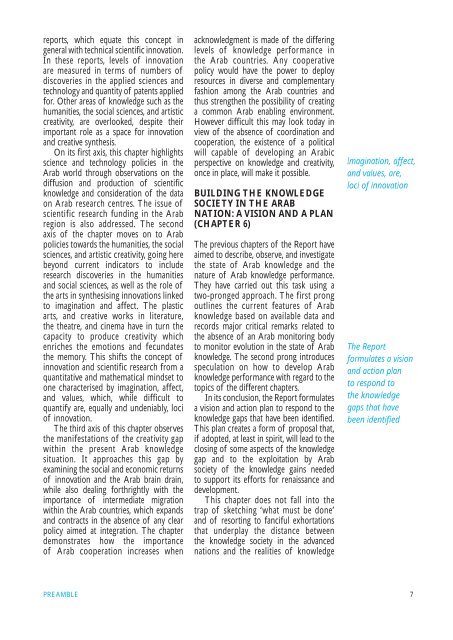Arab Knowledge Report 2009: Towards Productive
Arab Knowledge Report 2009: Towards Productive
Arab Knowledge Report 2009: Towards Productive
- No tags were found...
You also want an ePaper? Increase the reach of your titles
YUMPU automatically turns print PDFs into web optimized ePapers that Google loves.
eports, which equate this concept ingeneral with technical scientific innovation.In these reports, levels of innovationare measured in terms of numbers ofdiscoveries in the applied sciences andtechnology and quantity of patents appliedfor. Other areas of knowledge such as thehumanities, the social sciences, and artisticcreativity, are overlooked, despite theirimportant role as a space for innovationand creative synthesis.On its first axis, this chapter highlightsscience and technology policies in the<strong>Arab</strong> world through observations on thediffusion and production of scientificknowledge and consideration of the dataon <strong>Arab</strong> research centres. The issue ofscientific research funding in the <strong>Arab</strong>region is also addressed. The secondaxis of the chapter moves on to <strong>Arab</strong>policies towards the humanities, the socialsciences, and artistic creativity, going herebeyond current indicators to includeresearch discoveries in the humanitiesand social sciences, as well as the role ofthe arts in synthesising innovations linkedto imagination and affect. The plasticarts, and creative works in literature,the theatre, and cinema have in turn thecapacity to produce creativity whichenriches the emotions and fecundatesthe memory. This shifts the concept ofinnovation and scientific research from aquantitative and mathematical mindset toone characterised by imagination, affect,and values, which, while difficult toquantify are, equally and undeniably, lociof innovation.The third axis of this chapter observesthe manifestations of the creativity gapwithin the present <strong>Arab</strong> knowledgesituation. It approaches this gap byexamining the social and economic returnsof innovation and the <strong>Arab</strong> brain drain,while also dealing forthrightly with theimportance of intermediate migrationwithin the <strong>Arab</strong> countries, which expandsand contracts in the absence of any clearpolicy aimed at integration. The chapterdemonstrates how the importanceof <strong>Arab</strong> cooperation increases whenacknowledgment is made of the differinglevels of knowledge performance inthe <strong>Arab</strong> countries. Any cooperativepolicy would have the power to deployresources in diverse and complementaryfashion among the <strong>Arab</strong> countries andthus strengthen the possibility of creatinga common <strong>Arab</strong> enabling environment.However difficult this may look today inview of the absence of coordination andcooperation, the existence of a politicalwill capable of developing an <strong>Arab</strong>icperspective on knowledge and creativity,once in place, will make it possible.BUILDING THE KNOWLEDGESOCIETY IN THE ARABNATION: A VISION AND A PLAN(CHAPTER 6)The previous chapters of the <strong>Report</strong> haveaimed to describe, observe, and investigatethe state of <strong>Arab</strong> knowledge and thenature of <strong>Arab</strong> knowledge performance.They have carried out this task using atwo-pronged approach. The first prongoutlines the current features of <strong>Arab</strong>knowledge based on available data andrecords major critical remarks related tothe absence of an <strong>Arab</strong> monitoring bodyto monitor evolution in the state of <strong>Arab</strong>knowledge. The second prong introducesspeculation on how to develop <strong>Arab</strong>knowledge performance with regard to thetopics of the different chapters.In its conclusion, the <strong>Report</strong> formulatesa vision and action plan to respond to theknowledge gaps that have been identified.This plan creates a form of proposal that,if adopted, at least in spirit, will lead to theclosing of some aspects of the knowledgegap and to the exploitation by <strong>Arab</strong>society of the knowledge gains neededto support its efforts for renaissance anddevelopment.This chapter does not fall into thetrap of sketching ‘what must be done’and of resorting to fanciful exhortationsthat underplay the distance betweenthe knowledge society in the advancednations and the realities of knowledgeImagination, affect,and values, are,loci of innovationThe <strong>Report</strong>formulates a visionand action planto respond tothe knowledgegaps that havebeen identifiedPREAMBLE7
















